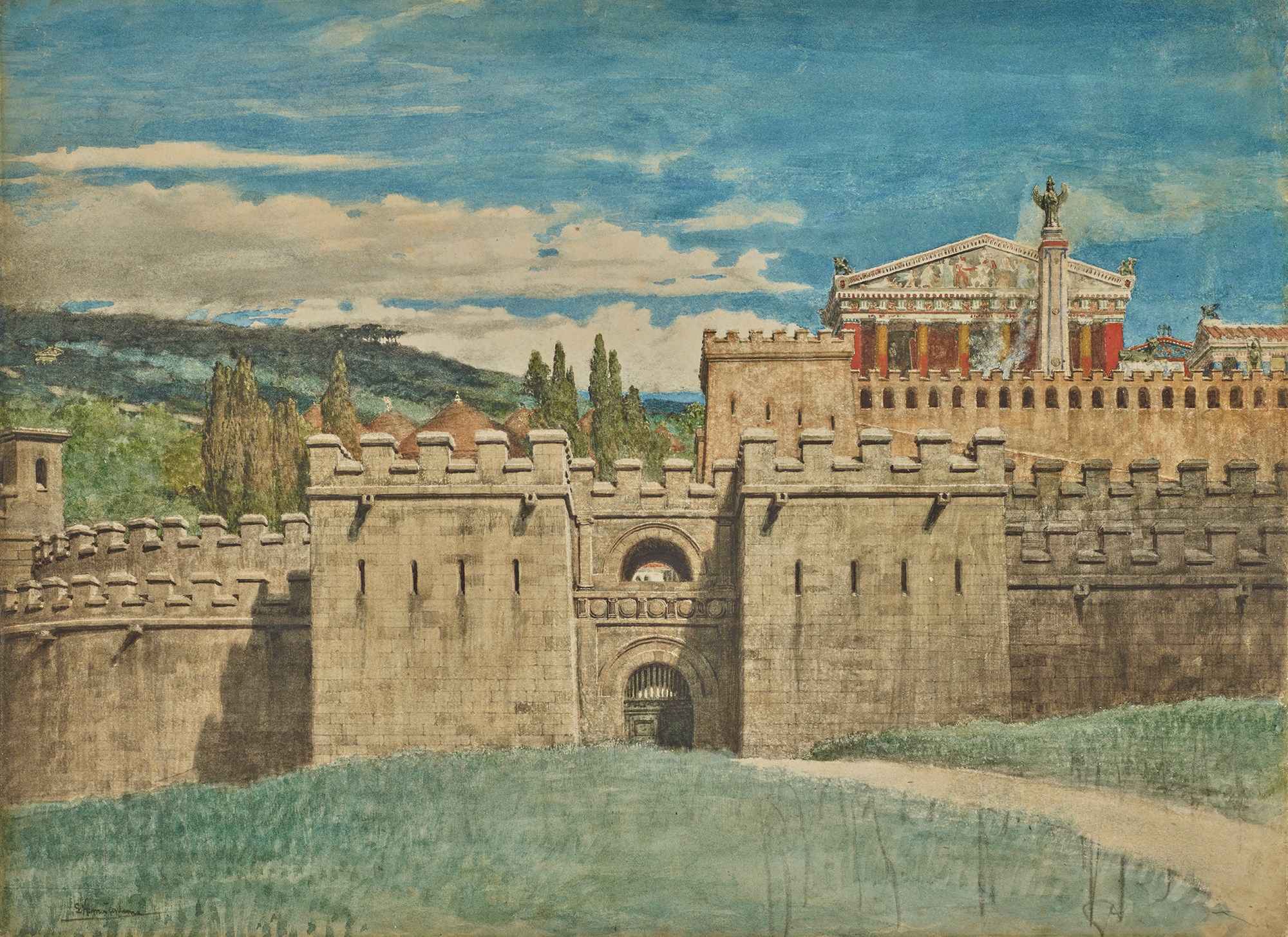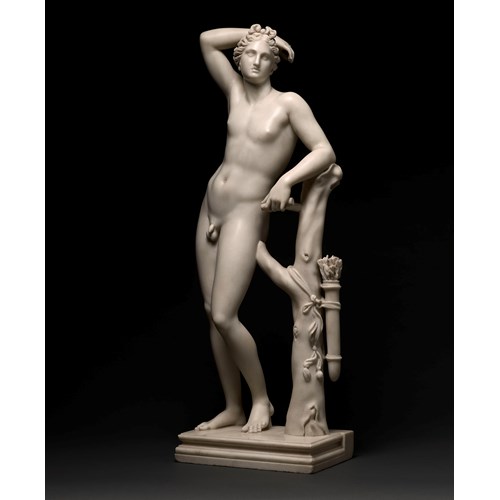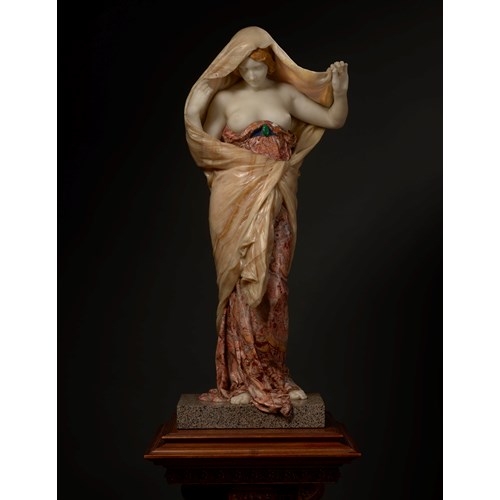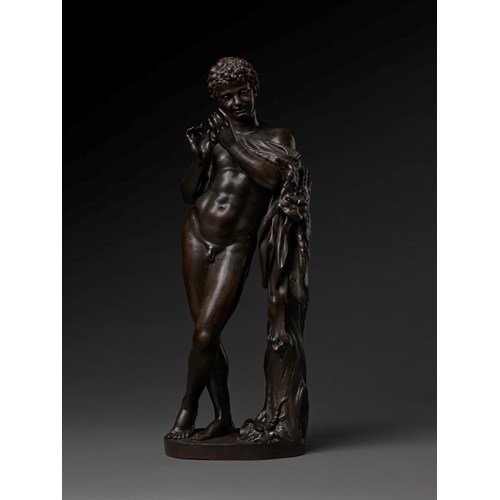Sir Lawrence Alma-Tadema
Antium seen from outside the city walls: Design for Sir Henry Irving’s production of William Shakespeare’s ‘Coriolanus’
Date c.1879
Medium watercolour and pencil
Dimension 38.5 x 51.5 cm (15¹/₈ x 20¹/₄ inches)
Irving (1838-1905), to design a production of William Shakespeare’s Coriolanus.1
Although the play is set in Rome during the fifth century BC and its heroes fought the
Volscians, Alma-Tadema opted for archaeological researched set designs after Etruscan
architecture and objects, to highlight the difference between a more provincial Antium
and the cultural epicentre of Rome. Alma-Tadema, faithful to his meticulous concern for
archaeological realism, was inspired by the discoveries of the painted tombs of Tarquinia,
Volterra, de Vulci and Cerveteri from the 1820s onwards.
He was equally inspired by his travels, as well as the abundant details given on the various
sites in the celebrated novel by George Dennis, The Cities and Cemetries of Etruria,
published in 1848, which had become the main reference for any erudite traveller
exploring the sites of Ancient Etruria. Alma-Tadema's stage set for Coriolanus is the
result of having carefully studied all the archaeological resources he could draw from (see
Colombe Couëlle, Alma-Tadema ou les couleurs de l’Antiquité, Travaux & Documents,
2007).
According to Bram Stoker, then director at the Lyceum theatre, and known as the author
of Dracula, ‘the idea was new of getting specialists in various periods to apply their
personal skill as well as their archaeological knowledge to stage effect… Irving
wanted things to be correct, well, knowing … that which is accurate is most likely to
convince’ (Personal Reminiscences of Henry Irving, 1906, volume II, pp. 65–66).
Tadema had achieved a ‘magnificent series of studies for the piece’ in July 1880, but it
would take another twenty-one years before the play would be performed at the Lyceum,
as Irving wanted to make the most of the youth of his lead actress Ellen Terry (1847-
1928), prioritising roles for her in Romeo and Juliet, Twelfth Night and Much Ado About
Nothing before returning to the Roman Tragedies. Coriolanus finally opened on 15 April
1901 with Irving himself in the lead role of Coriolanus, and Ellen Terry as Volumnia.
This watercolour was created by Alma-Tadema for Act III, but finally was not used in its
entirety, rather elements were incorporated into various scenes. Although the public did
not admire the performances by Irving and Terry, Tadema’s vision of ‘Rome and Antium
of the time of the Kings’ (c.500BC) was greatly admired (Prettejohn and Trippi, p. 180).
The design on this watercolour was described in 1913 as ‘Antium seen from outside the
city walls. In the entrance gateway we recognise the Etruscan gateway of Perugia
flanked by two enormous towers. The battlements and the walls are based on those
which have been found in the older part of Pompeii, there being an outer wall about
30ft. high and an inner wall beyond some 16ft. higher. Above the town walls is
another wall enclosing the citadel, the semi-circular openings which are similar to
those which existed in the walls of Servius Tullius at Rome. In the distance is the
principal temple, of the Tuscan order, with six columns in-antis based on the tomb
of Norchia. In front of the temple is the great altar, of which we see only the smoke
rising from the sacrifice, and in front of that lofty pedestal bearing the doublewinged
Phoenician goddess Astarte’.
Among the other rare survivors of Tadema’s designs for Coriolanus is a beautiful sheet,
now at the Victoria and Albert Museum (fig.4, E.2182-1924, 1901, 374 x 494 mm), and
the Interior of the Caius Martius’ House at the Manchester City Art Galleries.
Date: c.1879
Medium: watercolour and pencil
Signature: Signed lower left: L Alma Tadema
Dimension: 38.5 x 51.5 cm (15¹/₈ x 20¹/₄ inches)
Provenance: Acquired from the artist by Sir Henry Irving (1838-1905);
His posthumous sale, Christie’s, London, 16 December 1905, lot 23, where acquired by
Gooden & Fox, London;
Christie’s New York, 15 February 1985, lot 363;
Mainichi Auction, Tokyo, 7 December 2019, lot 921
French Art Market to 2024
Acquired from the above.
Literature: R.P. Spiers, ‘The Architecture of “Coriolanus” at the Lyceum Theatre’, Architectural
Review, X, 1901, pp. 20-21, ill. p.21;
R.P. Spiers, ‘Archaeological Research in the Paintings of Sir Lawrence Alma-Tadema',
Architectural Review, XXXIII, 1913, p. 48, ill. plate XIII ;
R. Barrow, Lawrence Alma-Tadema, London, 2001, ill. p. 166.
Exhibition: Scenic Artists’ Exhibition, London, 1905 (on loan from Henry Irving); Royal Academy,
London, Works by Sir Lawrence Alma-Tadema, R.A., O.M., 1913, n°133.
Plus d'œuvres d'art de la Galerie









